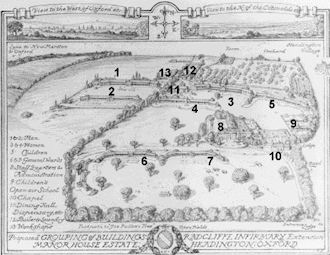Our history
To the Manor Born
In 1919 the Radcliffe Infirmary purchased the Manor House estate in Headington. The Infirmary site was already overcrowded, and they had been asked to provide sanatorium accommodation for tuberculosis sufferers. They had applied to the Radcliffe Trustees for the use of some of the Observatory land, but without success. A public appeal for funds was launched, and much of the purchase price came from the British Red Cross as part of the winding up of monies raised during the First World War; it was proposed that the new hospital should serve as a war memorial.
An early plan for the development of the Headington site

Image showing early plan of the Headington site.
Areas as follows:
- 1/2 - men's wards
- 3/4 - women's wards
- 5 - children's wards
- 6/7 - general wards
- 8 - staff quarters and administration
- 9 - children's open-air school
- 10 - chapel
- 11 - dining hall, dispensary etc
- 12 - boiler and laundry
- 13 - workshops
Roads and drainage for a tuberculosis hospital were laid, but financial difficulties intervened. In the event, the first hospital use of the site was when the Preliminary Training School of the newly established School of Nursing took up residence in the Manor House in 1922. The Ministry of Health finally approved the plans for the hospital for tuberculosis cases, and the Osler Pavilion opened in 1927, named after Sir William Osler (1849 - 1919), Regius Professor of Medicine.
The Infirmary's finances were still in a poor state. In May 1925, having learned that the value of the Manor House estate might be affected by a proposal for an arterial road, the Governors began to sell portions of the estate for building sites. A further large portion of the site was sold in the early 1930s when the Nuffield benefactions made extensive building necessary at the Infirmary. The present site of the John Radcliffe Hospital is only about half the size of the estate purchased in 1919.
The same need for funds had led to the sale of the Infirmary's Sunnyside estate in Cowley, which was used as a convalescent home. A 30 bedded convalescent hospital was built in the Manor House grounds to compensate; it was also called Sunnyside.
Post-war progress
After the Second World War there began a process of discussion and planning about the future of the hospital service in Oxford, which continued throughout the 1950s and was concerned especially with the relative merits of the Manor House and Churchill sites. The only building to be erected at Headington during this period was a nurses' home, which was completed in 1955. It was named Arthur Sanctuary House, in honour of the man who had been administrator of the Radcliffe Infirmary, 1921 - 1951.
In 1960 the Manor House site was chosen for the new hospital, and a planning team was appointed in 1963. Work began on Phase I, a new maternity hospital, in 1968. This building is now the John Radcliffe Hospital's Women's Centre. In the same year the Preliminary Training School left the Manor House. The maternity hospital opened in July 1972. Almost immediately the contract for Phase II was signed, and the acute hospital opened in 1979, with extensions continuing to the present day.
The United Oxford Hospitals, who had been responsible for the Radcliffe Infirmary since 1948, handed the new hospital over to the Oxfordshire Area Health Authority (Teaching) in 1974. In 1982 Oxfordshire Health Authority took over responsibility. The John Radcliffe Hospital was united with the Churchill Hospital as the Churchill John Radcliffe Hospital in 1993, and the Oxford Radcliffe Hospital NHS Trust was formed in 1994. This Trust took over responsibility for the Horton General Hospital in 1998 and for the Radcliffe Infirmary in 1999.
In 2007 the John Radcliffe West Wing, the Oxford Eye Hospital and the Oxford Children's Hospital opened on the John Radcliffe Hospital site. In October 2009 the Oxford Heart Centre opened.
The Oxford Radcliffe Hospitals NHS Trust merged with the Nuffield Orthopaedic Centre NHS Trust on 1 November 2011 to create the Oxford University Hospitals NHS Trust.
Following a successful application for Foundation Trust status in October 2015, the Trust is now called 'Oxford University Hospitals NHS Foundation Trust'.
For more on Oxfordshire Health History, visit Oxfordshire Health Archives.